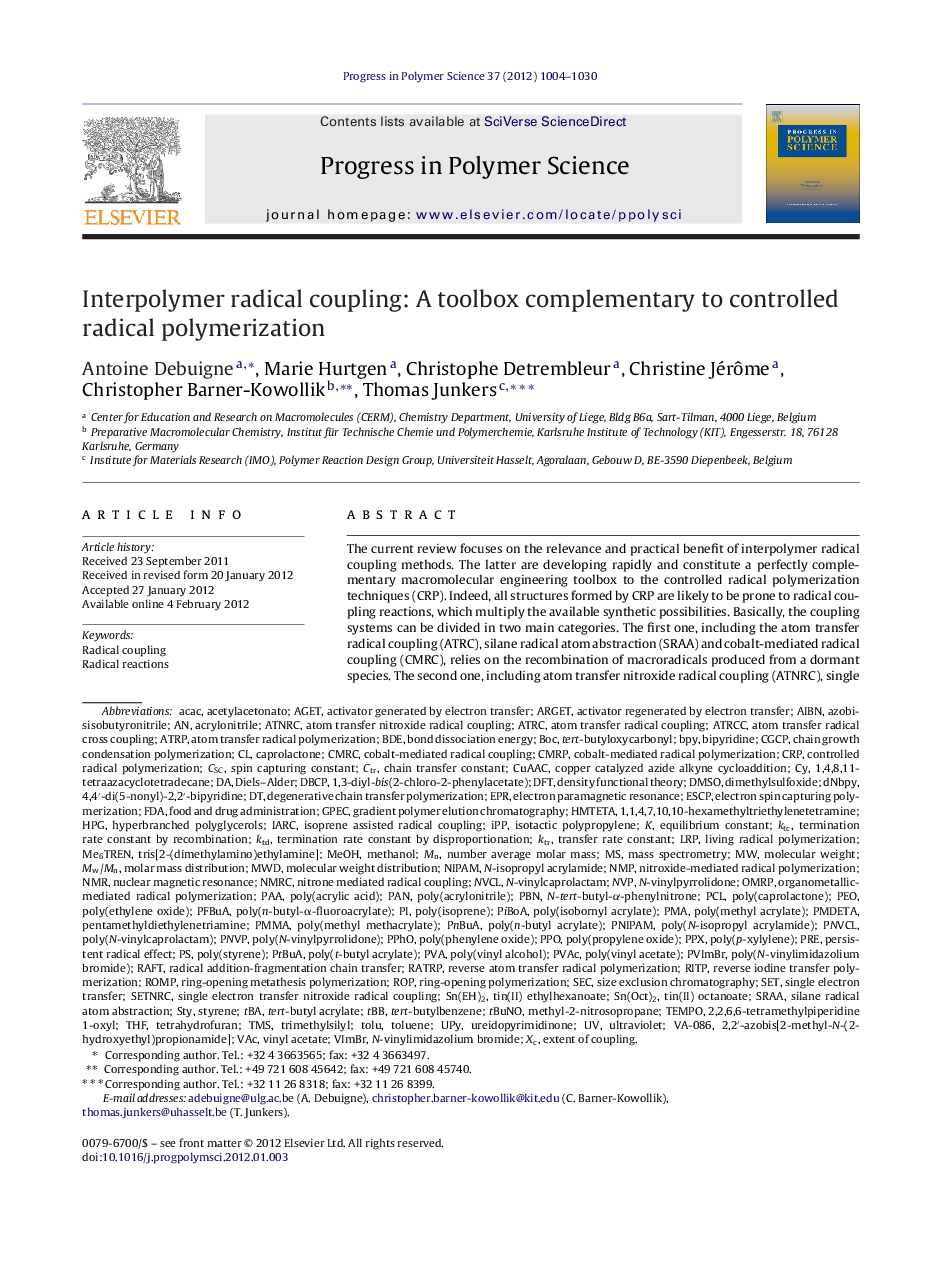| Article ID | Journal | Published Year | Pages | File Type |
|---|---|---|---|---|
| 5208343 | Progress in Polymer Science | 2012 | 27 Pages |
Abstract
The current review focuses on the relevance and practical benefit of interpolymer radical coupling methods. The latter are developing rapidly and constitute a perfectly complementary macromolecular engineering toolbox to the controlled radical polymerization techniques (CRP). Indeed, all structures formed by CRP are likely to be prone to radical coupling reactions, which multiply the available synthetic possibilities. Basically, the coupling systems can be divided in two main categories. The first one, including the atom transfer radical coupling (ATRC), silane radical atom abstraction (SRAA) and cobalt-mediated radical coupling (CMRC), relies on the recombination of macroradicals produced from a dormant species. The second one, including atom transfer nitroxide radical coupling (ATNRC), single electron transfer nitroxide radical coupling (SETNRC), enhanced spin capturing polymerization (ESCP) and nitrone/nitroso mediated radical coupling (NMRC), makes use of a radical scavenger in order to promote the conjugation of the polymer chains. More than a compilation of macromolecular engineering achievements, the present review additionally aims to emphasize the particularities, synthetic potential and present limitations of each system.
Keywords
PVACSCPCLSECBDETHFATRPPAALRPTBASTYMWDVACPPOCTRIPPMw/MnHPGROPAcAcBOCPVACtert-butyloxycarbonyltrimethylsilylNMPNVPAIBNPBNTBBKTRCuAACPNIPAMAzobisisobutyronitrileROMPChain transfer constantATRCbpyPMDETAARGETAtom Transfer Radical CouplingMe6TRENFDAN-vinylpyrrolidoneRATRPPoly(n-butyl acrylate)Poly(t-butyl acrylate)Poly(p-xylylene)RITPPNVCLPPXDBCPHyperbranched polyglycerolsTert-butylbenzenehmtetaTMSPNVPSRAAactivator generated by electron transferCMRPgradient polymer elution chromatography1,1,4,7,10,10-hexamethyltriethylenetetraminetransfer rate constantpentamethyldiethylenetriamine2,2,6,6-tetramethylpiperidine 1-oxylureidopyrimidinonenuclear magnetic resonance1,4,8,11-tetraazacyclotetradecaneDFTDMSOPMAN-tert-butyl-α-phenylnitroneN-Isopropyl acrylamidePoly(N-isopropyl acrylamide)IARC یا International Agency for Research on CancerRadical couplingPersistent radical effectStyreneacetylacetonatoSn(Oct)2UltravioletAtom transfer radical polymerizationbond dissociation energyAcrylonitrileBipyridineTetrahydrofurantert-butyl acrylateNMREPRElectron paramagnetic resonanceEquilibrium constantSETMolar mass distributionMolecular weight distributionTolueneSingle electron transferDiels–AlderDimethylsulfoxideRAFTTEMPOFood and Drug AdministrationMass spectrometryprePANMacrocyclesMethanolMeOHN-vinylcaprolactamDensity functional theoryNIPAMRadical reactionsMolecular weightVinyl acetateCRPPoly(N-vinylpyrrolidone)Poly(N-vinylcaprolactam)poly(acrylonitrile)Poly(propylene oxide)Poly(methyl methacrylate)PMMAPoly(caprolactone)Poly(phenylene oxide)poly(ethylene oxide)Poly(styrene)poly(acrylic acid)Poly(methyl acrylate)Poly(vinyl acetate)Poly(vinyl alcohol)Isotactic polypropyleneTelechelic polymersRing-opening polymerizationLiving radical polymerizationNitroxide-mediated radical polymerizationReverse atom transfer radical polymerizationcontrolled/living radical polymerizationControlled radical polymerizationRing-opening metathesis polymerizationPEOCaprolactoneAGETSize exclusion chromatographyBlock copolymersUPy
Related Topics
Physical Sciences and Engineering
Chemistry
Organic Chemistry
Authors
Antoine Debuigne, Marie Hurtgen, Christophe Detrembleur, Christine Jérôme, Christopher Barner-Kowollik, Thomas Junkers,
